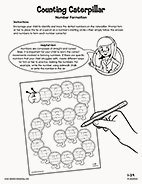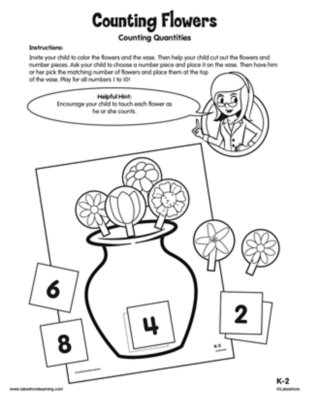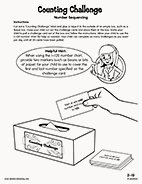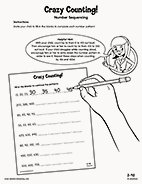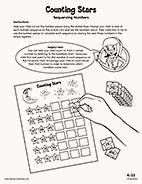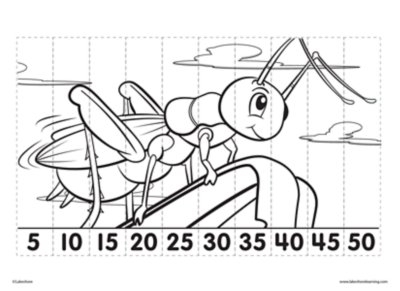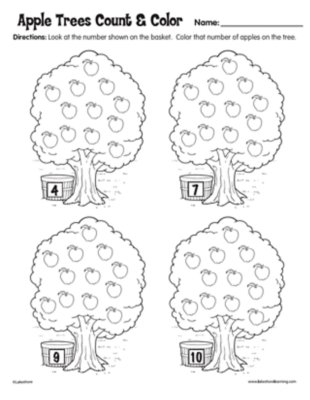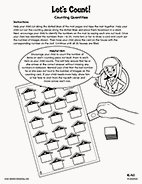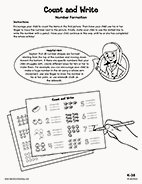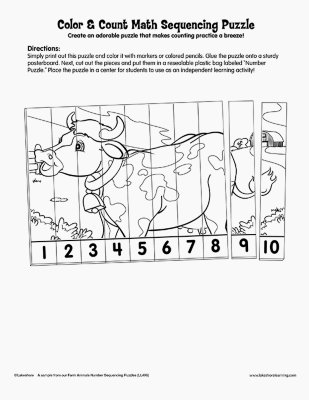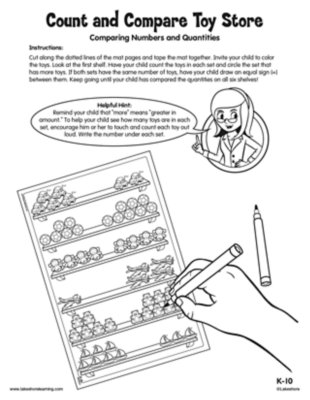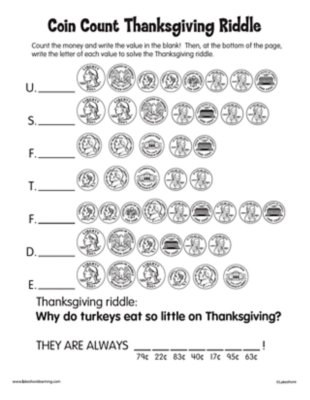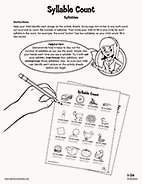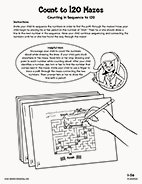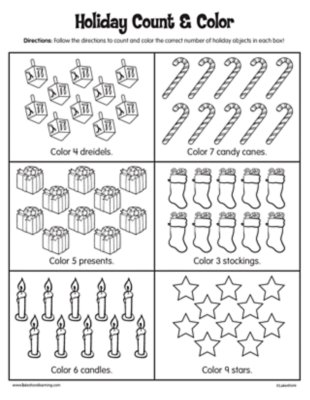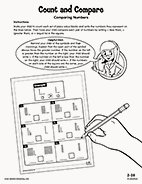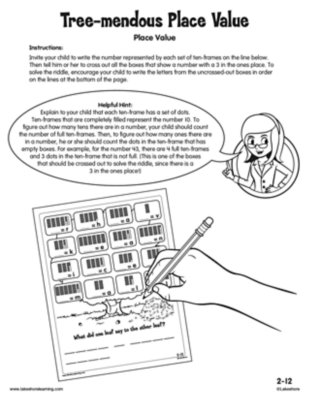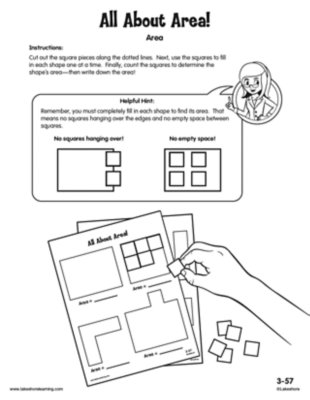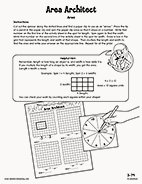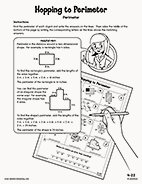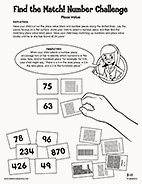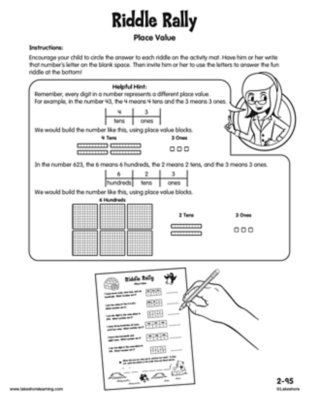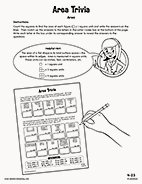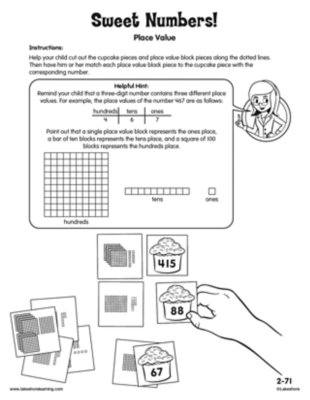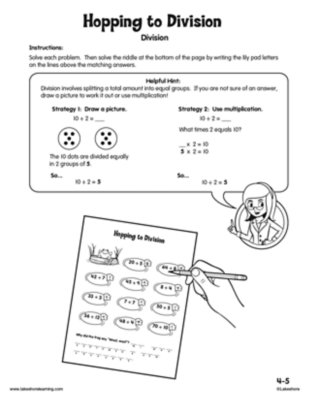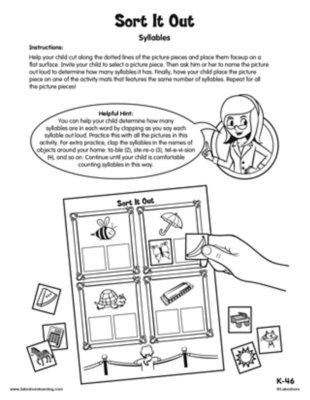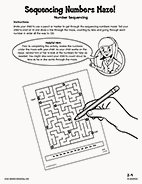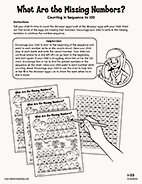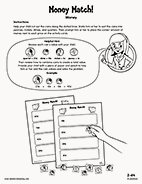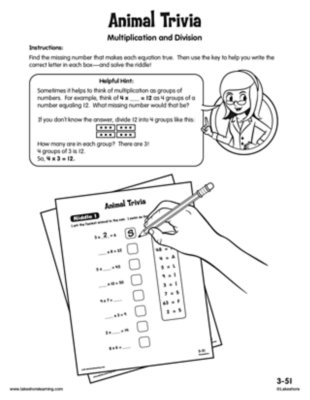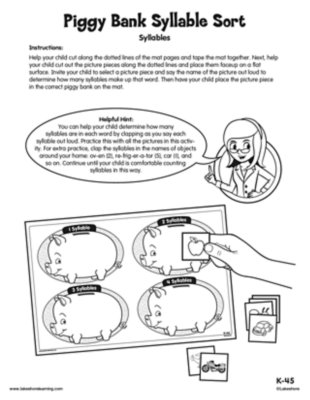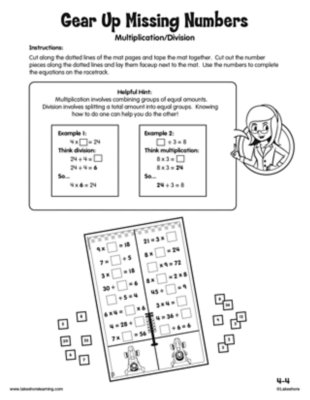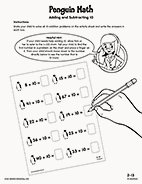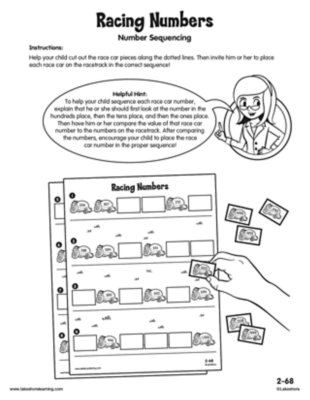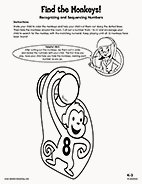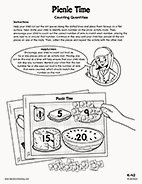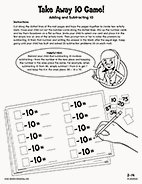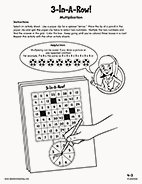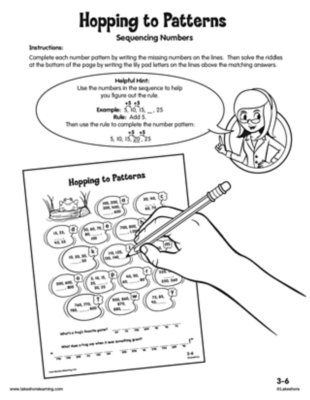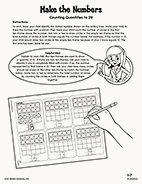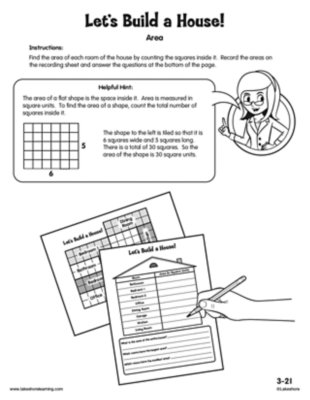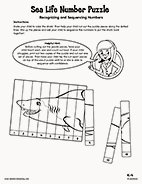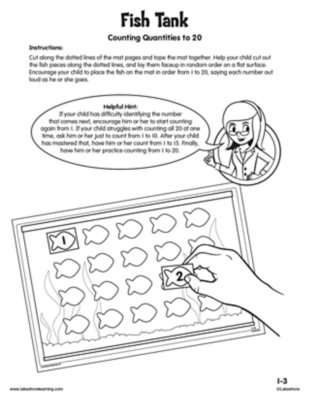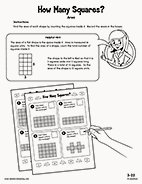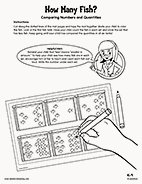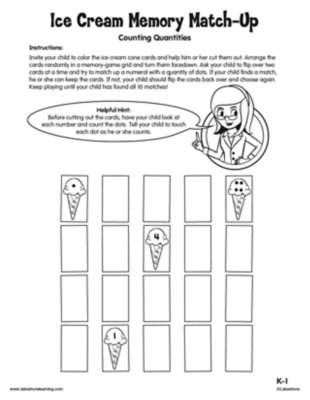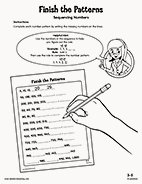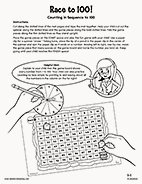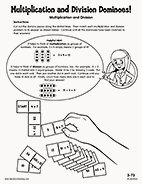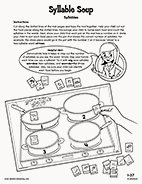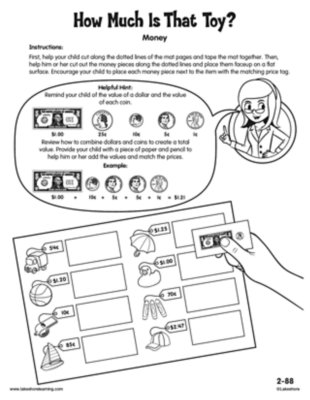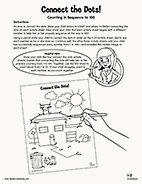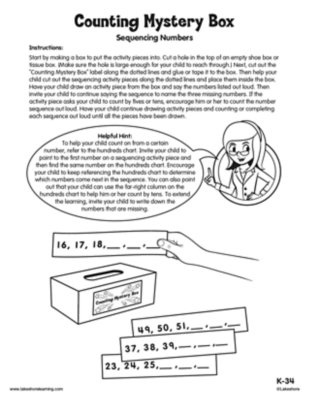
During kindergarten, your child will learn to count in sequence from 1 to 100 by ones (1, 2, 3, 4…) and tens (10, 20, 30, 40…).
View worksheetWhen entering first grade, your child should be able to print many uppercase and lowercase letters and write numbers 0 through 20.
View worksheetWhen entering kindergarten, your child should be able to count to tell the number of objects.
View worksheetWhen entering second grade, your child should be able to count, read and write numbers up to 120, beginning with any number. For example, 116, 117, 118, 119, 120.
View worksheetDuring second grade, your child will learn to count and sequence numbers within 1,000 and skip-count by 2s, 5s, 10s and 100s.
View worksheetDuring kindergarten, your child will learn to count in sequence from 1 to 100 by ones (1, 2, 3, 4…) and tens (10, 20, 30, 40…).
View worksheetDuring kindergarten, your child will learn to count as many as 20 objects at a time.
View worksheetDuring kindergarten, your child will learn to write numbers 0 through 20.
View worksheetWhen entering kindergarten, your child should be able to count groups of up to 10 objects and determine if one group of objects is more than, less than or equal to the other.
View worksheetWhen entering first grade, your child should be able to count and say the syllables in spoken words. For example, your child should understand that “kitten” has two syllables: kit•ten.
View worksheetDuring first grade, your child will be asked to count to 120, beginning with any number. For example, 116, 117, 118, 119, 120.
View worksheetWhen entering second grade, your child should be able to determine if a two-digit number is greater than, less than or equal to another two-digit number and use the >, < and = symbols to show the answer.
View worksheetWhen entering second grade, your child should be able to see groups of tens and ones when counting. Your child should also understand that the two digits in a two-digit number represent tens and ones. For example, there are 3 tens and 2 ones in the number 32.
View worksheetDuring third grade, your child will learn to find the area of a shape by counting unit squares or multiplying side lengths. Your child will also learn to find the perimeter of a shape by adding side lengths.
View worksheetDuring third grade, your child will learn to find the area of a shape by counting unit squares or multiplying side lengths. Your child will also learn to find the perimeter of a shape by adding side lengths.
View worksheetWhen entering fourth grade, your child should know how to find the area of a shape by counting unit squares or multiplying side lengths. Your child should also know how to find the perimeter of a shape by adding side lengths.
View worksheetWhen entering second grade, your child should be able to see groups of tens and ones when counting. Your child should also understand that the two digits in a two-digit number represent tens and ones. For example, there are 3 tens and 2 ones in the number 32.
View worksheetDuring second grade, your child will learn to identify groups of hundreds, tens and ones when counting. Your child will also learn that the three digits in a three-digit number represent hundreds, tens and ones. For example, there are 7 hundreds, 2 tens and 6 ones in the number 726.
View worksheetWhen entering fourth grade, your child should know how to find the area of a shape by counting unit squares or multiplying side lengths. Your child should also know how to find the perimeter of a shape by adding side lengths.
View worksheetDuring second grade, your child will learn to identify groups of hundreds, tens and ones when counting. Your child will also learn that the three digits in a three-digit number represent hundreds, tens and ones. For example, there are 7 hundreds, 2 tens and 6 ones in the number 726.
View worksheetWhen entering fourth grade, your child should be able to quickly and easily solve multiplication and division facts within 100 without having to count. For example, 9 x 9 = 81 and 56 ÷ 8 = 7.
View worksheetDuring kindergarten, your child will learn to count and say the syllables in spoken words. For example, your child should understand that “kitten” has two syllables: kit•ten.
View worksheetWhen entering second grade, your child should be able to count, read and write numbers up to 120, beginning with any number. For example, 116, 117, 118, 119, 120.
View worksheetDuring first grade, your child will be asked to count to 120, beginning with any number. For example, 116, 117, 118, 119, 120.
View worksheetDuring second grade, your child will count dollar bill and coin combinations.
View worksheetDuring third grade, your child will learn to quickly and easily solve multiplication and division facts within 100 without having to count. For example, 9 x 9 = 81 and 56 ÷ 8 = 7.
View worksheetDuring kindergarten, your child will learn to count and say the syllables in spoken words. For example, your child should understand that “kitten” has two syllables: kit•ten.
View worksheetWhen entering fourth grade, your child should be able to quickly and easily solve multiplication and division facts within 100 without having to count. For example, 9 x 9 = 81 and 56 ÷ 8 = 7.
View worksheetWhen entering second grade, your child should be able to mentally add 10 to or subtract 10 from any two-digit number—without having to count. For example, 32 + 10 = 42 and 35 — 10 = 25.
View worksheetDuring second grade, your child will learn to count and sequence numbers within 1,000 and skip-count by 2s, 5s, 10s and 100s.
View worksheetWhen entering kindergarten, your child should be able to recognize numbers 1 to 20 and count them in sequence.
View worksheetDuring kindergarten, your child will learn to count as many as 20 objects at a time.
View worksheetWhen entering second grade, your child should be able to mentally add 10 to or subtract 10 from any two-digit number—without having to count. For example, 32 + 10 = 42 and 35 — 10 = 25.
View worksheetWhen entering fourth grade, your child should be able to quickly and easily solve multiplication and division facts within 100 without having to count. For example, 9 x 9 = 81 and 56 ÷ 8 = 7.
View worksheetWhen entering third grade, your child should be able to count and sequence numbers within 1,000 and skip-count by 5s, 10s and 100s.
View worksheetWhen entering first grade, your child should be able to count as many as 20 objects at a time.
View worksheetWhen entering third grade, your child should be able to divide a rectangle into rows and columns of same-size squares and count to find the total number of them.
View worksheetWhen entering kindergarten, your child should be able to recognize numbers 1 to 20 and count them in sequence.
View worksheetWhen entering first grade, your child should be able to count as many as 20 objects at a time.
View worksheetWhen entering third grade, your child should be able to divide a rectangle into rows and columns of same-size squares and count to find the total number of them.
View worksheetWhen entering kindergarten, your child should be able to count groups of up to 10 objects and determine if one group of objects is more than, less than or equal to the other.
View worksheetWhen entering kindergarten, your child should be able to count to tell the number of objects.
View worksheetWhen entering third grade, your child should be able to count and sequence numbers within 1,000 and skip-count by 5s, 10s and 100s.
View worksheetWhen entering first grade, your child should be able to count to 100 by ones (1, 2, 3, 4…) and tens (10, 20, 30, 40…).
View worksheetDuring third grade, your child will learn to quickly and easily solve multiplication and division facts within 100 without having to count. For example, 9 x 9 = 81 and 56 ÷ 8 = 7.
View worksheetWhen entering first grade, your child should be able to count and say the syllables in spoken words. For example, your child should understand that “kitten” has two syllables: kit•ten.
View worksheetDuring second grade, your child will count dollar bill and coin combinations.
View worksheetWhen entering first grade, your child should be able to count to 100 by ones (1, 2, 3, 4…) and tens (10, 20, 30, 40…).
View worksheet
